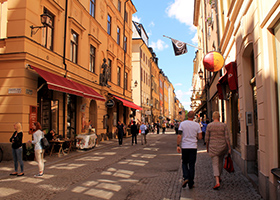Helsinki, Stockholm and Copenhagen are all working strategically with pedestrian prioritising and urban life.
Car free city centres are high on the political agenda in many Nordic cities and in a range of European countries. New policy measures are applied and in many cases, significant increases in the car-free downtown area are planned. A new report from Institute of Transport Economics in Norway describes car free city-centre areas in Helsinki, Stockholm and Copenhagen.

In Stockholm new areas are prioritised for pedestrians. Photo: Shutterstock
The pedestrian areas in the three cities are of different sizes. Although there remains some work before the refinement and design of the expanded car-free area of Oslo is finalised, it is likely that this will be substantially larger than that of the three cities described in this report.
Copenhagen is characterised by a gradual expansion of the pedestrian streets from the ’60s, spreading from the shopping street Strøget, followed by the incorporation of new streets and squares in a stepwise process. In Stockholm, there has long been strong restrictions on car use in Gamla Stan, but new areas are prioritised for pedestrians. In Helsinki, there is an ongoing discussion and planning of pedestrian priorities in the city, including the expansion of the current pedestrian area and other measures for pedestrians. None of the three cities have done what Oslo is planning to do; to expand the pedestrian zone significantly within a short period.
None of the three cities’ downtown areas are totally pedestrianised. There are various exceptions, including goods delivery, service cars, residents and people with disabilities. Goods distribution is allowed at given times in all three areas. In Helsinki, goods delivery has partially been moved to an underground tunnel system. In both Copenhagen and Stockholm there are consolidation centres relieving the pedestrian zone.
All three cities are working strategically with pedestrian prioritising and urban life. In these strategies, non-motorists are considered main contributors to urban life and vitality of downtown areas. However, the cities have had and still have different strategies and approaches for establishing pedestrianised centre areas.
The report was prepared with funding from the Norwegian Public Roads Administration (Statens vegvesen) and the Nordic Road Association (Nordisk vägforum), and builds on the TOI report “European Cities with pedestrianised centre“ written by Tønnesen Meyer, Skartland and Sundfør (published in 2016).
The report is written in Norwegian but you can read more in the English summary of the report: Car-free city solutions in three Nordic cities. TØI Report 1552/2017
Authors: Oddrun Helen Hagen, Anders Tønnesen and Karin Fossheim
 Contact:
Contact:
Oddrun Helen Hagen
ohh@toi.no
TØI, Norway
 Contact:
Contact:
Anders Tønnesen
ato@toi.no
TØI, Norway
 Contact:
Contact:
Karin Fossheim
kfo@toi.no
TØI, Norway






Follow us: